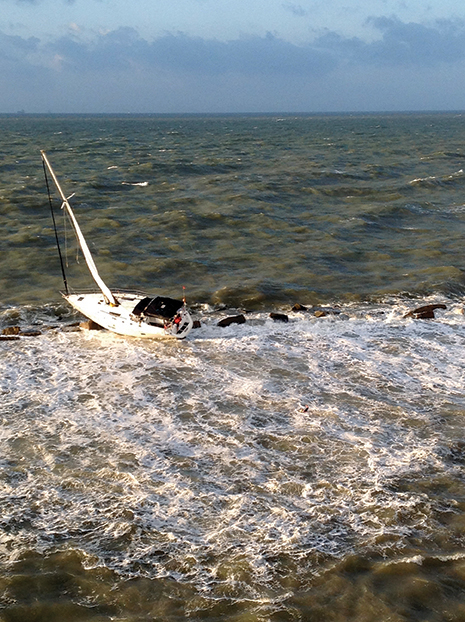Today’s sailor has a wide array of devices to call for help in an emergency (published May 2016)
Several years ago during the annual Fastnet Race from Cowes to Fastnet Rock and back, the crew of Rambler 100—a 100 foot super maxi—had the sudden, unlucky experience of having the boat’s keel fall off, not far from the rock’s lighthouse. With no keel, the boat rolled over and stabilized itself upside down. A few of the crew were able to basically walk up to the dry side as the boat rolled but most could not and found themselves in the water or under water inside the boat.
It happened so fast that no one was able to undertake the practiced emergency drill. The life rafts were not deployed. The EPIRBs were underwater and did not have hydrostatic releases so they did not begin sending the satellite based SOS. It was getting dark and the crew was frantically trying to get everyone onto the overturned hull before darkness consumed them. As it happened, none of the crew was carrying their Personal Locator Beacons (PLBs). Except one.
The boat’s crew chief, Mick Harvey, was one of the last to be pulled from the water. He was wearing his foul weather pants and had on sea boots that filled with water and almost dragged him to the bottom. Veteran crewman Jerry Kirby who was already on the boat managed to grab Mick’s hand and drag him to safety. It was a lucky thing for Mick. And a lucky thing for the crew. In Mick’s fanny pack was his PLB. He set it off and within minutes the world was alerted to the fact that he was in dire straits and along with him the whole crew of Rambler 100.
Within hours, rescue vessels arrived and plucked the crew from their overturned race boat. No one was lost and that is because Harvey was saved from drowning and had his PLB with him.
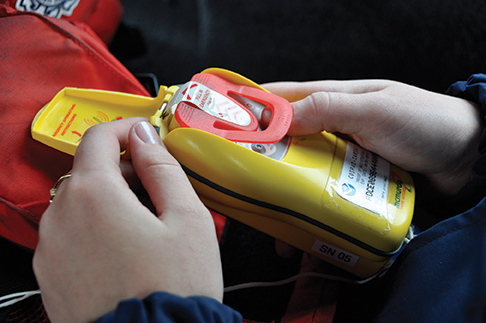
SATELLITE COMMUNICATIONS
With this cautionary tale in mind, it is worth noting that the development of satellite communications has saved more lives and reduced rescue times so dramatically that the sea is now a much safer place than it was 40 years ago. Back then, the crew of Rambler 100 would most likely have been lost at sea.
It is worth noting that in 1979, the year of the famous Fastnet Race disaster in which many boats were lost and sailors perished, the maritime nations of the world got together to create a worldwide, coordinated search and rescue system. The resulting agreement created what is known as the Global Marine Distress and Safety System (GMDSS) that set out to use modern satellite and VHF technology to save lives at sea around the world.
The first leap into satellite safety devices was the development of Emergency Position Indicating Beacons (EPIRBs) and the network of shore stations to relay SOS messages to the appropriate rescue services and Coast Guard stations. An EPIRB is registered with the ship’s details, owner’s and emergency contact information. In the U.S., EPIRB owners register with the National Oceanic and Atmospheric Administration (NOAA) where the national register of EPIRBs is kept on file.
The devices broadcast a specific coded signal on 406 MHz that is received by NOAA satellites and then rebroadcast to the nearest land station. The signal then is redirected to the rescue service with jurisdiction for the area where the signal originated and the search and rescue effort begins.
In the early days, EPIBs broadcast a second signal on 121 mHz that could be tracked by aircraft flying over the device; even commercial jets at 35,000 feet could hear the ping and be able to take a bearing on it. Rescue aircraft could home in on the signal and hopefully find and rescue the crew in distress. It was advanced science but still somewhat inexact.
The addition of GPS to EPIRBs greatly improved the ability of rescuers to locate a crew since they now have the exact GPS coordinates for the device, which hopefully is with the crew. This potent combination of an immediate satellite signal, a ready rescue team, a homing signal and an exact position means that those in distress at sea will be rescued in a matter of hours instead of the days or even weeks as it was in the days before EPIRBs were invented.
Obviously, every vessel that sails offshore should carry an EPIRB and all commercial vessels are required to carry them. But an EPIRB doesn’t do you much good in a man overboard emergency in which a crewmember gets separated from the boat and his crew is tasked to find and rescue him.
Once again, the satellites come to the rescue. The development of miniature circuitry and long lived and powerful lithium batteries made it possible to reduce the size of an EPIRB so it could fit neatly into your pocket or be clipped unobtrusively to your foul weather gear or PFD. Now every sailor can carry with him a small but powerful signaling device that will send his GPS position in the water to the satellites and initiate a rescue. Plus, the device broadcasts on 121 MHz as well so the crew of the boat from which he fell can home in on the device using a dedicated homing locator.
Since the development of satellite based emergency signaling devices, a reported 28,000 people have been rescued and saved with the technology.
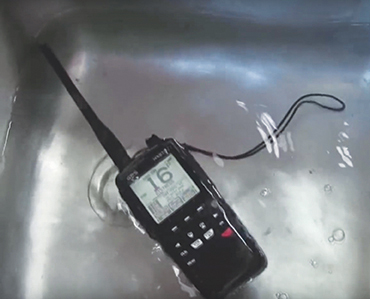
VHF SIGNALING
While emergencies at sea are always a contingency to plan for, most dire situations afloat happen close to home and within the range of VHF radios. In the last few years the U.S. Coast Guard has completed the Rescue 21 VHF network that has placed automated VHF antenna strategically around the country’s shorelines—oceans and lakes—that receive signals from up to 20 miles offshore. Rescue 21 operates similarly to satellite signaling and is the first line of defense that will launch a rescue party to find you and provide assistance. Rescue 21 is a part of the U.S.’s commitment to building out the technology identified in the DMDSS agreements.
The system works with the Digital Selective Calling function built into most modern VHF radios designed for marine use. DSC allows you to call other DSC radio users on a private frequency instead of on the open airwaves. But it is also the protocol used by Rescue 21. Modern VHF radios have a DSC Distress function that, when switched on, sends a dedicated SOS to the network and can initiate a rescue.
But the Coast Guard reports that fewer than 20 percent of VHFs with DSC functionality are set up to make them work with the Rescue 21 system. Like EPIRBs and PLBs, VHF radios with DSC Distress calling capability need to be registered, and you need to load them with a dedicated MSSI number that is specific to you and your boat. Plus, you need to interface your VHF with a GPS so the DSC distress signal carries all of your relevant information and your exact GPS location. In the U.S., you register and get your MSSI number through Boat US.
On a cruising or voyaging boat, VHF radios with DSC will also work around the globe in countries that are partners in the GMDSS worldwide network—satellite and VHF protocols. So, when you get to a new landfall, check to see how you can register for the local DSC Distress network.
VHF is also an important part of being rescued at sea. Every ditch kit should have a submersible handheld radio in it so you will be able to talk with rescuers as a rescue is being coordinated. It is a vital part of your offshore safety kit.
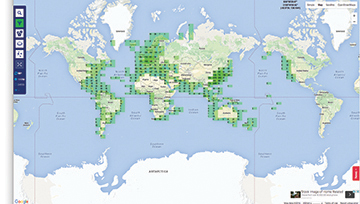
VHF & AIS
VHF is a line of sight form of radio communication so it is particularly useful in ship to ship communications. In emergency situations, VHF voice communications are the best way to make sure everyone knows what is going on.
But VHF also has a digital safety signaling function that in recent years has changed how ships interact in crowded waters and how we think about man overboard emergencies. The Automated Identification System (AIS) uses VHF based shipboard transponders that allow vessels to send out and receive signals with their vital information, including course, speed, ID and MSSI numbers to all other ships within VHF range.
This automated, two way communications shows up on either dedicated AIS receivers or can be integrated into the vessel’s navigation electronics so the AIS data gets displayed on a chart plotter’s screen. AIS will track vessels around you and will give you range, bearing and time to closest encounter. In a collision emergency, AIS will alert you with a sound signal. The development of AIS has reduced ship collisions dramatically and has made life on a cruising boat infinitely safer.
But AIS also is a new and exciting system to help search and rescue in man overboard emergencies. Dedicated personal AIS beacons are coming on the market that are small enough to be carried in a pocket and robust enough to survive an immersion.
These personal AIS beacons send out an AIS signal that shows up on all nearby vessels’ AIS receivers or chart plotters that pinpoints exactly where the man overboard is. Better than a homing device for a PLB broadcasting on 121 MHz, the new AIS devices will allow recuers to navigate directly to the person in the water.
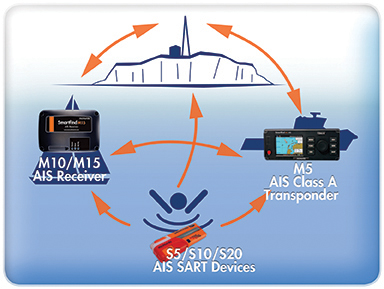
An AIS device will have a GPS built in as well as a bright strobe light that will be visible from a mile or more way. The AIS signal covers a circle with a radius about four miles, which is a line of sight distance from the surface of the water to a raised antenna on a sailboat.
BEING RESCUED
The technology is out there to make your life at sea much safer than it has ever been. Sailors are rescued every week because they were carrying an EPIRB or personal safety beacon. BWS urges all sailors to plan for and prepare for emergencies at sea and know how to send emergency distress signals when help is needed. Being rescued is the outcome you hope you’ll never need but you will be eternally grateful to the signaling devices when you do.















